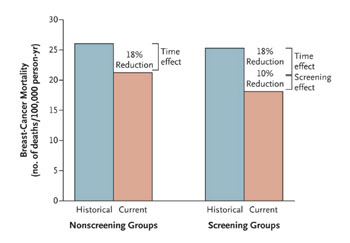Research Suggests A Better Approach to Breast Cancer Screening
By MedImaging International staff writers
Posted on 14 Jun 2016
Researchers are unhappy with current models for determining mammography screening risk/benefit ratios, and suggest that the measurement of Quality-Adjusted Life-Years (QALYs) gained, when breast cancer is prevented, could be more accurate.Posted on 14 Jun 2016
Researchers in Norway found that there were large uncertainties in the evaluation a long running breast cancer screening program in the country, especially in the estimates of over-diagnoses.

Image: Research shows that the Norwegian Breast Cancer Screening Program reduced mortality (Photo courtesy of the NBCSP).
The researchers from the Department of Screening at the Cancer Registry of Norway (Oslo, Norway) studied the benefit/detriment ratio estimates of the Norwegian Breast Cancer Screening Program (NBCSP) in 2015, and presented the results at the annual meeting of the Radiological Society of North America (RSNA 2015). The results were published in the March 2016, issue of the Journal of Medical Screening. Under the program, all women aged 50 to 69 receive an invitation for screening every two years. The Research Council of Norway also evaluated the screening program between 2007 and 2015.
According to the researchers, the range of estimates varies widely and needs to be interpreted carefully before publication. In addition the estimates include two different variables that are not comparable — lives saved and cases of over-diagnosis. The researchers found that the program saved about one life per 1-2 women with epidemiologic over-diagnosis. The researchers suggest that using a simple risk/benefit ratio could be misleading. Instead, they propose the use of Quality-Adjusted Life-Years (QALYs) gained when breast cancer is prevented, compared to QALYs lost in cases of over diagnosis.
Norway’s health minister decided to continue the NBCSP program without changes despite the findings of the researchers.
Solveig Hofvind, PhD, researcher, Department of Screening, Cancer Registry of Norway, said, “Our research demonstrates that it’s very difficult to find clear numbers to show the risk/benefit ratio of mammography screening. The range is so wide and it depends on so many different factors, that it’s important to understand the screening logistics and the epidemiology in order to choose the right model to estimate such a ratio. In any event, if a patient asks for information about risk/benefit ratios, that information should be shared and interpreted with substantial. I know women may ask about this ratio and we have to be prepared to give them information with the best knowledge we have today.”
Related Links:
Cancer Registry of Norway














